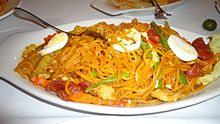Pancit
Pancit [ ˈpansɪtˈ ] is the name of a Filipino noodle dish that originated in China. Through constant regional adjustments with various ingredients, the dish has developed into one of the most famous national dishes of the Filipino cuisine . Pancit is served in numerous variations, especially at parties and birthdays. Typical ingredients besides the noodles, which are the main component of the dish, are local meats, fish and vegetables.
History and etymology
The Filipino cuisine is a potpourri of various cultural influences, shaped by the historical and social developments of the island state. While the roots of Filipino cuisine are believed to be in Malaysia, Chinese and Indian influences through trade and Spanish and American influences through colonization cannot be denied. In particular, the early trade relations between China and the Philippines, which already existed during the Tang period (618–907 AD), had a lasting influence on the Philippine food culture.
With the Chinese traders, noodle and rice dishes came to the Philippines, whose Chinese roots can still be traced from their names. The term pancit also comes from the Hokkien- Chinese pian + e + sit , which translated means something like “something that has been conveniently, appropriately, practically cooked.” Since the processing of noodles is known to be less time-consuming, the name has changed Pancit in the Philippines for the said noodle dish, naturalized. In addition, "in the 19th century [...] Chinese noodle restaurants, which are generally referred to as panciterias."
The common use of pancit at celebrations or birthdays can also be attributed to a Chinese tradition. Accordingly, pasta symbolizes a long and healthy life. Instead of candles, the noodles were filled with orange eggs, golden fried shallots and green onion leaves. To this day, pancit is an appropriate and favored dish on birthdays and other celebrations in the Philippines.
Pancit types and variations
Over time, the Chinese noodle dish has developed into the Filipino pancit, which has been continuously varied with local meat, fish and vegetables. Today's ingredients and variations of the dish are mostly not used in Chinese cuisine or at least not used in these combinations. The numerous variations of pancit differ both in their type of pasta as the main component of the dish and in the remaining components and ingredients. The two main main variants of the dish to be distinguished are pancit canton and pancit bihon. While Pancit Bihon consists of thin, transparent rice noodles, Pancit Canton is made up of slightly thicker egg noodles that look similar to the well-known spaghetti noodle. The ingredients for the pancit are also very individual depending on the region in the Philippines. Shrimps, fish and mussels are used more frequently directly on the coasts and more eggs or vegetables such as carrots, beans or onions further inland. For the preparation, the ingredients are usually fried in a pan with oil, while the noodles are briefly placed in water beforehand and then mixed with the remaining ingredients and spices and fried. Other well-known pancit variants include Pancit Buko, Pancit Malabon, Pancit Marilao and Pancit Molo.
supporting documents
literature
- Cathrin Bullinger, Stefan Seitz, Andreas Volz: The Jollibee phenomenon: "Filipino in taste - making proudly Filipino". In: International Asia Forum. 43rd vol., No. 3–4, 2012.
- Doreen G. Fernandez: Culture Ingested: Notes of the Indigenization of Philippine Food . In: Philippine Studies. Volume 36, Number 2, 1988, pp. 219-232.
Individual evidence
- ↑ a b Pancit: Filipino Noodle Dish. In: guampedia.com. July 7, 2014, accessed January 10, 2015 .
- ↑ cf. Doreen G. Fernandez: Culture Ingested: Notes of the Indigenization of Philippine Food . In: Philippine Studies. Volume 36, Number 2, 1988, pp. 219-232.
- ↑ cf. Chris Rowthorn, Greg Bloom et al: Philippines . Victoria: Lonely Planet, 2006, ISBN 1-74104-289-5 , p. 47.
- ↑ cf. Gilda Cordero-Fernando: The Culinary Culture of the Philippines . Manila, Bancom Audiovision Corporation, 1976, pp. 24-29.
- ^ A b Cathrin Bullinger, Stefan Seitz, Andreas Volz: The Jollibee phenomenon: "Filipino in taste - making proudly Filipino" . In: International Asia Forum . 43, No. 3–4, 2012, pp. 301 ff .. (PDF, 460 kB)
- ↑ Gloria Chan-Yap: Hokkien Chinese Influence on Tagalog Cookery . In: Philippine Studies: Historical and Ethnographic Viewpoints. Vol. 24, No. 3, 1976, pp. 288, 300.
- ↑ a b cf. Jeremy Atiyah et al .: The rough guide to southeast asia . 2002, Rough Guides Ltd., ISBN 1-85828-893-2 , p. 804 ( limited preview in Google book search)
- ^ Nancy Reyes-Lumen: Republic of Pancit . In: Food and the Filipino: Feast and Famine . No. 1, Jan-March 2005.
- ↑ cf. Doreen G. Fernandez: Tikim: essays on Philippine food and culture . 1994, Pasig, Metro Manila: Anvil Publishing, pp. 40-43.
Web links for recipes / preparation
- Sabrina Hase: Traditional pancit. In: chefkoch.de. August 12, 2007, accessed January 10, 2015 .
- Pancit: Filipino Noodle Dish. In: guampedia.com. July 7, 2014, accessed January 10, 2015 .
- How to Make Filipino Pancit. In: youtube.com. September 11, 2011, accessed January 10, 2015 .
